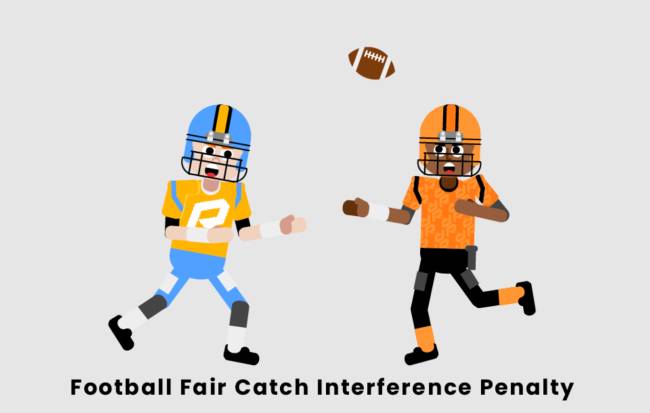You might see the receiving team on a kick wave their arm before catching it when you watch a football game on TV or in person.
Waving your hand signals that the receiving unit is making a fair catch. What is a fair catch, why do teams use it, and what happens if there is a penalty? Below are the answers to these questions.
Table of Contents
What is a Fair Catch in American Football?
In American football, a fair catch occurs when the receiving team does not run the ball back after catching a punt or kickoff. The play becomes dead once the returner signals a fair catch by waving his arm before catching the ball.
The play is still dead even if the receiver muffs the ball and recovers it before it hits the ground. In other words, the offense starts their first down where the catch was made.

Why Have a Fair Catch in Football?
A fair catch rule in the NFL serves two purposes. Firstly, it protects the punt returner or kick returner from injury. The kicker might make a short punt, so the receiver won’t have enough time to catch and react to an oncoming tackle. When kicking a punt, not reacting quickly enough could result in an injury because members of the kicking team crash receivers so quickly.
A fair catch also provides field position and prevents the ball from being fumbled on contact. If a receiver catches a punt and is immediately hit by a special team’s defender, the punt might result in a fumble. Due to the receiver’s focus on the ball, they might not react quickly enough to a defender and lose the ball on direct contact. When you call the fair catch and secure the catch, your offense at least has a chance to score.
What is the Fair Catch Signal in the National Football League?
Fair catch signals occur when the receiver extends and waves his arm above his head while the ball is in the air. Upon a catch, the officials must signal the fair catch and blow the whistle to alert the kicking team that the play is dead.
What is an Illegal Fair Catch?
Fair catch signals are invalid when a player does not fully raise their arm over their head to call for the catch. If a fair-catch movement is invalid, the referees move the ball five yards back to where the player made the signal. It is common for referees to give players some slack if the motion was not 100% clear but the intent was obvious.
The illegal fair catch call is intended to protect players on offense and defense. If the kicking team tackles the receiver who is not expecting a tackle, it could result in an injury. Secondly, if the kicking team was unaware of the receiver’s intentions, an illegal fair catch prevents the fair catch interference penalty.
When Was the Fair Catch Rule Implemented in the NFL?
Back in 1921, the Green Bay Packers made the first successful fair catch in the NFL. It was the Evansville Crimson Giants who faced the Packers.
Where Do you Start on Offense after a Fair Catch Kick?
A successful fair catch gives the offense their first down after they called and caught the ball. Your offense will begin playing on the eight-yard line if you call a fair kick on the eight-yard line.
What Happens if you Call a Fair Catch and Drop It?
The ball is up for grabs by either team if a player calls for a fair catch and then drops it. For instance, if the kicked ball bounces off a receiver’s chest during a fair catch and hits the ground, and the receiving team recovers the ball on the ground, they now possess the ball. When the defense recovers the ball on a punt, it can change the momentum of a game, so everyone needs to be prepared.
What Happens if a Defensive Player Hits You on a Fair Catch?
The kicking team receives a fifteen-yard penalty if the punting team tackles you (or even runs into you) after correctly calling for a fair. Upon receiving the signal, the return team automatically moves up fifteen yards to begin its offensive drive. The receiver cannot make contact with the kicking team after calling for the fair catch, or they will be penalized fifteen yards backward.
Conclusion
In American Football, the fair catch is used to protect players from injury and fumbles. In the National Football League, the kicking team can no longer get a running start before a kickoff takes place to encourage safety. It also allows better judgment on when to use the fair catch by limiting how quickly the defense can get to the receiver.
A receiver can also kneel after catching a ball in the end zone on a kick. On a kick or punt catch, the offense team kneels in the end zone to receive a touchback. Taking a knee in the end zone on a catch puts the offense on the 25-yard line.
FAQs
A fair-catch kick is worth 3 points, similar to a field goal. As with a standard kick return, 6 points are awarded if the return team returns a fair-catch kick for a touchdown.
With limited time left on the clock, teams should be aware of this ruling for field position reasons. A punt must be made from Team A’s end zone. The game is tied 14-14 with ten seconds left on the clock. A team’s punter can punt the ball 25-30 yards.
Team B’s field goal kicker might be able to kick a 40-yard field goal if they fair catch the punt. Rather than throwing a Hail Mary and hoping for the best, this gives the team better odds.
